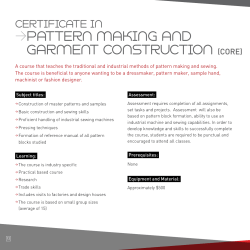
How to Assess a Choice Based Art Program CASSIDY REINKEN
How to Assess a Choice Based Art Program CASSIDY REINKEN What is Choice-Based Art and TAB? Teaching for Artistic Behavior (TAB) is a nationally recognized choicebased art education (CBE) approach to teaching art. The Teaching for Artistic Behavior concept enables students to experience the work of the artist through authentic learning opportunities and responsive teaching. http:teachingforartisticbehavior.org/tab-practice/assessment/ Choice-Based Art Resources http://ecx.images-amazon.com/images/I/617cuQkry5L._SL500_AA300_.jpg http://ecx.images-amazon.com/images/I/61bfwqUaGmL._SX258_BO1,204,203,200_.jpg TAB Resources Choice-Based Art Teachers Value Risk-taking Following a line of though over time Going deep with a preferred medium or technique Playing and experimenting Bringing aspects of their life into their art http:teachingforartisticbehavior.org/tab-practice/assessment/ Why Give Students Choice? Choice in the art room allows students to create art based on their own ideas, interests, hobbies, talents, and strengths. Increased student engagement Increased understanding and proficiency in standards Increase in student satisfaction Decrease in negative behaviors Increase in student reflection Backwards Design and Choice-Based Art Backwards design helps teachers create course and units that are focused on the goal (learning) rather than the process (teaching.) http://edglossary.org/backward-design/ What do I want my students to know? VS. How am I going to teach it? By starting with the end in mind, you are ensuring it is your focus throughout the whole lesson. Visual Art Standards and Choice “Learning standards describe educational objectives—i.e., what students should have learned by the end of a course, grade level, or grade span—but they do not describe any particular teaching practice, curriculum, or assessment method (although this is a source of ongoing confusion and debate.)” http://edglossary.org/learning-standards/ Designing a Choice-Based Art Lesson 1. Review grade level standards 2. Choose power standards to assess 3. Choose a common theme 4. Design the how summative assessment will be used and design form and or student reflection form 5. Create demonstrations/mini lessons for the project 6. Choose formative assessment strategies to use 7. Teacher and Student Reflection Assessment and Choice-Based Art “Artistic behaviors are honored and noted in the ongoing daily assessment process.” “Choice-based art education uses multiple forms of assessment to support student and teacher growth.” http:teachingforartisticbehavior.org/tab-practice/assessment/ What am I Grading? Process vs. Product Intended Outcome Engagement Student Reflection Collaboration Proficiency in the Standards Formative Assessment Student-Teacher Conferences Gallery Walks Daily Charts Exit Slips Class Wind Down Talk Thumbs Up/Thumbs Down Journals Class Dojo App (Behavior Management) Summative Assessment Self Reflection Forms via: Socrative Edmodo Canvas Dropbox Pencil and Paper Standards Referenced Grading “In a standards-referenced grading system, a student’s status is reported (or referenced) relative to the performance standard for each area of knowledge and skill on the report card; however even if the student does not meet the performance standard for each topic, he or she moves to the next level.” –Robert Marzano Formative Assessment & Standards Based Grading by Robert Marzano 4 Point Grading Scale for SRG Advanced Exceeding Expectations 4 Proficient Meeting Expectations 3 Basic Approaching Proficiency 2 Below Basic No Understanding 1 Topic: Creating art: using media, techniques, and processes for creation Standard 1a. Students will handle art materials responsibly 4.0 In addition to score 3.0, students go above and beyond what is taught such as: Peer-coaching/helping other students use materials responsibly. Cleans and organizes group workstations and centers independently without prompts 3.0 Consistently demonstrates how to get out and put away supplies in the correct location. Consistently takes care of materials and uses them appropriately (i.e.: washing brushes, closing glue, cap on markers, tapping chalk off paper- not blowing it, etc. Cleans and organizes group workstations and centers when asked. 2.0 Frequently, but not consistently, demonstrates how to get out and put away supplies in the correct location. Beginning to demonstrate understanding of how to use materials appropriately. Requires occasional reminders for appropriate use. 1.0 Requires frequent reminders to put supplies away in the correct location. Unable to use materials appropriately independently. Student Self-Reflection Self-reflection happens repeatedly throughout the creation process. Students self-reflect through formative and summative assessments. The summative assessment for all projects is a self-reflection form students fill out at the end of the instruction sequence. *Introduction activity to teach students self-reflection strategies and expectations for the forms. Spring Art: Students will create art showing their feelings about spring. SLE’s: demonstrate problem solving and create art showing ideas and feelings. I see the sun and the clouds. The sun is pinkish purple. In the middle there is a giant ice cream cone with 3 flavors and a cherry on top. On the side there is a puddle of ice cream. It is in a big though bubble leading down to a girl who is dreaming about it. She is sad because she wants it. My drawing has many colors. They are realistic for the girl how she looks and the flavors of the ice cream. The space was used wonderfully. There not much left. Most of the page is used and the drawing is very big. I emphasized the drawing by making the ice cream bigger so it is the main thing, it is the biggest and in the middle. What I’m trying to show and say in this is that it is starting to get warm and you’ll get hot and it will be wonderful and you’ll start to crave something as in ice cream. So my girl is dreaming about the ice cream as it gets warm. I had a problem with the skin color then I talked to Mrs. Reinken and she showed me an idea and I did it. My project showed feelings because it is getting warmer to it shows spring. Students LOVE Choice! “My favorite thing about art class was that we could just come in for 50 minutes during the day and be ourselves. We didn't have to be what the cookie cutter seventh grader is (like in science, we're all expected to know Newton's three laws) and we could just express ourselves through artwork.” -Haylee “My favorite thing about art class is that we are allowed to create and use anything we want. We are able to have an idea of something no then bring it to life.” -Lauren “My favorite thing about this art class is the creativity that we can use in here, the environment overall is perfect in my view because we make up how we can feel about the project and we can create it putting step by step with our thoughts and feelings put into it.” -Tara Students LOVE Choice! “We get to make things that come out of our imagination and our creativity. I get to chose on what I want to do and what I want draw.” Margaret “Choice helps because then we don't have instructions to follow so then we kind of have to figure out how to do it on our own and so it helps us become better artists because we don't always have directions to follow .” –Rylee “This has helped me as an artist because I am not contained to work on something I do not want to do.” -Blake Students LOVE Choice! “The choice based curriculum that art follows helped me to become a better artist because I wasn't assigned a cookie cutter project, and I was able to figure out who I really am.” –Haylee “Having lots of choice in what and how I created my art helped me as an artist, because I was able to pick something I was passionate about and create things. I was able to express myself through my art.” -Sarah “Since I was given a lot of choice in what and how I create, it has helped me as an artist because, I am able to experiment with materials and ideas that I have.” -Lauren Next Steps: Choose themes for each grade level Pick standards to assess for each theme Choose materials for students to use Create summative assessment Demonstrate skills/concepts Choose CHOICE in Your Art Room! Cassidy Reinken cassidyreinken@theartofed.com
© Copyright 2025





















